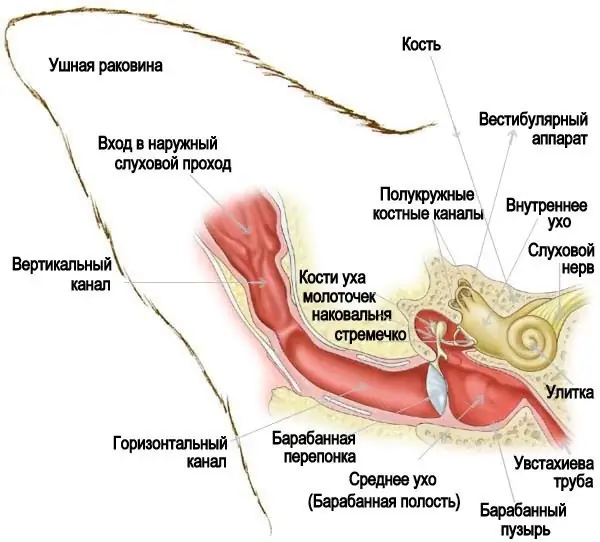2025 Author: Priscilla Miln | [email protected]. Last modified: 2025-01-22 17:55:19
Mastopathy in dogs is a tumor disease that develops in the mammary gland. Veterinarians often encounter this tumor in their practice. In the vast majority of cases, it is diagnosed in females over 6 years of age.
The 4th and 5th mammary glands are often affected by this disease. The reason for this is their increased functional activity. Initially, one tumor begins to develop, but if the treatment is delayed, it can develop into a multiple one.
Seals in the mammary glands of a dog are most often associated with estrus or pregnancy. At this time, they increase. Normally, after this period, they should return to their original state. In cases where this does not happen, pathology begins to develop, expressed in the appearance of abnormal formations.
Forms of mastopathy
Tumors in the mammary glands of a dog can be of several types. Often they arebenign neoplasms (60%), but some of them may be cancerous (40%). Since different types of cells are involved in the process, a visual examination of the tumor does not make it possible to determine whether the neoplasm is benign or malignant.
Some scientists put forward the assertion that mastopathy in dogs does not act as a particularly dangerous disease. However, this is an erroneous opinion, since even a benign formation without proper treatment can develop into a cancerous tumor.
Mastopathy is divided into fibrocystic and diffuse. With the development of the fibrocystic form, the nodules grow rapidly. It is most common in older animals. This seal may be single or multiple.

Often, diffuse mastopathy begins to develop before estrus (a few days before it starts). In the absence of the necessary therapy, it can develop into a fibrocystic form.
Most veterinarians consider breast disease to be a precursor to cancer. That is why you should not delay contacting a specialist.
A photo of mastopathy in a dog is presented in the article.
Causes of occurrence
Mastitis is considered the main cause of the development of the disease. Most often, this pathology can be observed in females who have given birth to dead puppies. Also, a possible cause of mastitis is the contamination of the glands with pathogenic microorganisms or fungi. In the absence of timely therapy, inflammatory processes beginspread and become the cause of mastopathy. In addition, a false pregnancy is capable of provoking this disease. It is quite rare to find the development of mastopathy in a lactating female.

Symptomatics
Symptoms of mastopathy in dogs can be different. However, the disease can be identified with certainty by the following symptoms:
significant breast enlargement;

- granular or wiry glands, detected by palpation;
- presence of secretion of ichor from the nipples;
- pain in the area of the mammary gland, accompanied by the dog's attempts to lick it;
- rapid weight loss;
- complete renunciation of food and water;
- manifestation of apathy and weakness;
- hair loss at the sites of tumor formation and increased skin temperature;
- appearance of ulcerative foci.
The main sign that the disease has passed into the malignant stage is a cough. The occurrence of this symptom indicates a metastatic lesion of the internal organs.
Stages of mastopathy
Tumours often affect the 3rd-5th lobes of the mammary gland. The reason for this is their structure, namely the large volume of glandular tissues in these parts of the organs. Mostly the disease begins with the development of single small formations. If other lobes are involved in the tumor, then this indicates the occurrence of a serious pathological process, which says thatneoplasms began to spread. The consequence may be the defeat of metastases of the lymph nodes and internal organs.
The early stage of development of mastopathy in dogs is characterized by the presence of small single mobile formations, in which there is no severe pain. The severity of the pathological process depends on the size of the tumors and their spread.
Cancer process is characterized by pain reaction, strong local hyperthermia and redness. The tumor does not have well-defined boundaries, since the growth of malignant cells passes to the surrounding nearby tissues. In this case, it is not possible to identify the foci of inflammation. This is a consequence of the fact that there is no formation of a barrier between he althy and diseased tissues. A feature of malignant tumors is that they are motionless, as they grow together with muscles and skin.
The late stage of development of mastopathy differs from others in the large size of the tumor. Its diameter can reach more than 20 cm, and weight - several kilograms. At this stage, the site of tumor development is covered with skin defects in the form of non-healing ulcers and abscesses. There is a significant increase in the lymph nodes and when pressed, the dog feels severe pain.
Diagnosis

Diagnosis of tumor pathology in the mammary gland of a dog is as follows:
- Feeling the mammary glands of a female, which is first in a standing position, and then in a lying position. This is necessary to exclude the diagnosis of hernia anddetection of affected lobes.
- Determination of soreness, consistency, size and mobility of the affected areas.
- Examination of all lymph nodes to which there is access in order to exclude the spread of metastases.
- Carrying out tissue biopsy and morphological examination of material subject to pathology.
- X-ray examination of the abdominal and chest cavities, in order to exclude the presence of metastases in the internal organs.
In the initial stages of mastopathy, there is rarely pain, even in cases where the tumor diameter reaches 10 cm and several lobes are involved. The formation has a well-defined shape without inflammatory processes affecting the surrounding tissues. The level of mobility and the density of the consistency depend on the size of the formation.
Involvement in the pathological process of the lymph nodes does not occur immediately. With the development of mastopathy, there is an increase in lymph nodes and loss of their mobility. However, pain is not observed. Also, to diagnose mastopathy, biochemical studies are carried out for the following hormones:
- follicle-stimulating;
- luteotropic;
- progesterone;
- estradiol.
An increase in their level can be a sign of the development of mastopathy in a dog. However, it should be clarified that these same signs are not characteristic of developing pathologies of the reproductive organs. Thus, the diagnosis, referring solely to the results of biochemistry, will not be correct. To be completely sure, you need tobiopsy.
Biopsy
Biopsy is the most accurate way to identify a tumor. Imprint smears provide an opportunity to diagnose, which will help choose the optimal treatment method. Biopsy involves fixing smears with absolute alcohol solution and their subsequent staining according to May-Grunwald and azure-eosin.
Treatment regimen
In the initial stages, the veterinarian observes and examines the dog before and during each estrus. Treatment of mastopathy in a dog can be carried out using homeopathic remedies that maintain a stable state of the nodes or remove them.
If a diffuse form of the disease develops, the veterinarian prescribes hormone therapy. If the development of a fibrocystic form of mastopathy in a dog occurs, surgery cannot be avoided. For older dogs, surgery is contraindicated. It can be carried out only in case of heart or liver disease. Surgery is not always a guarantee of full recovery as relapses may occur.

In cases where the formation of the dog is very large and metastasis has already begun, the operation does not make sense. In rare cases, if it makes sense, the veterinarian may order surgery to remove part of the growth. This will make it possible to prolong the life of the dog, but does not guarantee a complete cure.
Treatment at home
If for some reason it is not possible to visit a specialist, you can treat mastopathy in a dog at homeconditions. However, this should not be continued for a long time and it is necessary to show the dog to the veterinarian as soon as possible. Since it is impossible to conduct at home those studies that the doctor will conduct to determine the treatment regimen, this visit should not be delayed. In addition, the owner may simply not know how to treat mastopathy in a dog, and his treatment will be ineffective, which will bring even more harm to the pet.
Self-treatment of the disease involves the regular application of a cool compress to sore nipples. You can massage them twice a day. To prevent stagnation of milk, it is necessary to apply to the nipples of puppies. If purulent discharge appears from the nipples, puppies are prohibited.

Possible Complications
The lack of timely treatment can lead to the development of a number of complications in the dog. First of all, there is a threat of growth of education into a cancerous tumor. If the tumor has passed into the metastasized stage, then in most cases it is not possible to cure the animal, and only proper care can help prolong its life.
Launched mastopathy can cause the development of sarcoma, mixed tumor, adenocarcinoma.
The transformation of a tumor into a malignant most often occurs in poodles, shepherd dogs, giant schnauzers and cocker spaniels.

Prevention measures
In order to avoid the development of mastopathy, it is necessary to regularly bring the dog for examination. Two will be enoughvisits per year. In addition, you can give your dog drugs that prevent the formation of nodules and cysts. One of the most reliable preventive measures is sterilization. Proper care of the animal and a balanced diet will also help prevent the occurrence of mastopathy.
Recommended:
Increased hemoglobin in dogs: causes, symptoms, treatment, diet

If a veterinarian says a dog has high hemoglobin, what does that mean? This question is asked by absolutely all pet owners who are poorly versed in medical terms and in everything related to the he alth of pets. Why this happens and how to deal with pathology - we will tell further
Mastocytoma in dogs (mast cell tumor in dogs). What is this disease? Causes, treatment, prognosis

Various tumors and neoplasms, both malignant and benign, occur not only in humans, but also in pets. In addition, some types of diseases, such as mastocytomas, are more common in dogs than in humans. What is the treatment for this disease and what is it all about?
Cushing's syndrome in dogs: symptoms and treatment. Cushing's syndrome in dogs: how long do they live?

Today we want to talk about a serious endocrine disease that is common in dogs, and it is called Cushing's syndrome. How to recognize its symptoms, undergo the correct diagnosis and treatment? Answers to these and other questions in our article
Otitis in dogs: treatment with antibiotics and folk remedies. Types and symptoms of otitis media in dogs

Otitis is an inflammation of the ear, which gives a lot of discomfort not only to people, but also to our smaller brothers. It is worth noting that animals are much more likely to suffer from such an ailment. If, after cleaning your pet's ears, you notice that the dog's ears are dirty again the next day, she constantly scratches them and shakes her head, and the secretion secreted smells unpleasant, then you should immediately visit a veterinarian
Mastopathy and pregnancy: causes, symptoms, treatment

Mastopathy is a disease that can be diagnosed in women at any age. Often, pathological proliferation of mammary gland tissues is first detected during pregnancy. Pain in the chest, discharge from the nipples - these symptoms should not be ignored. Women with mastopathy are at risk for breast cancer

